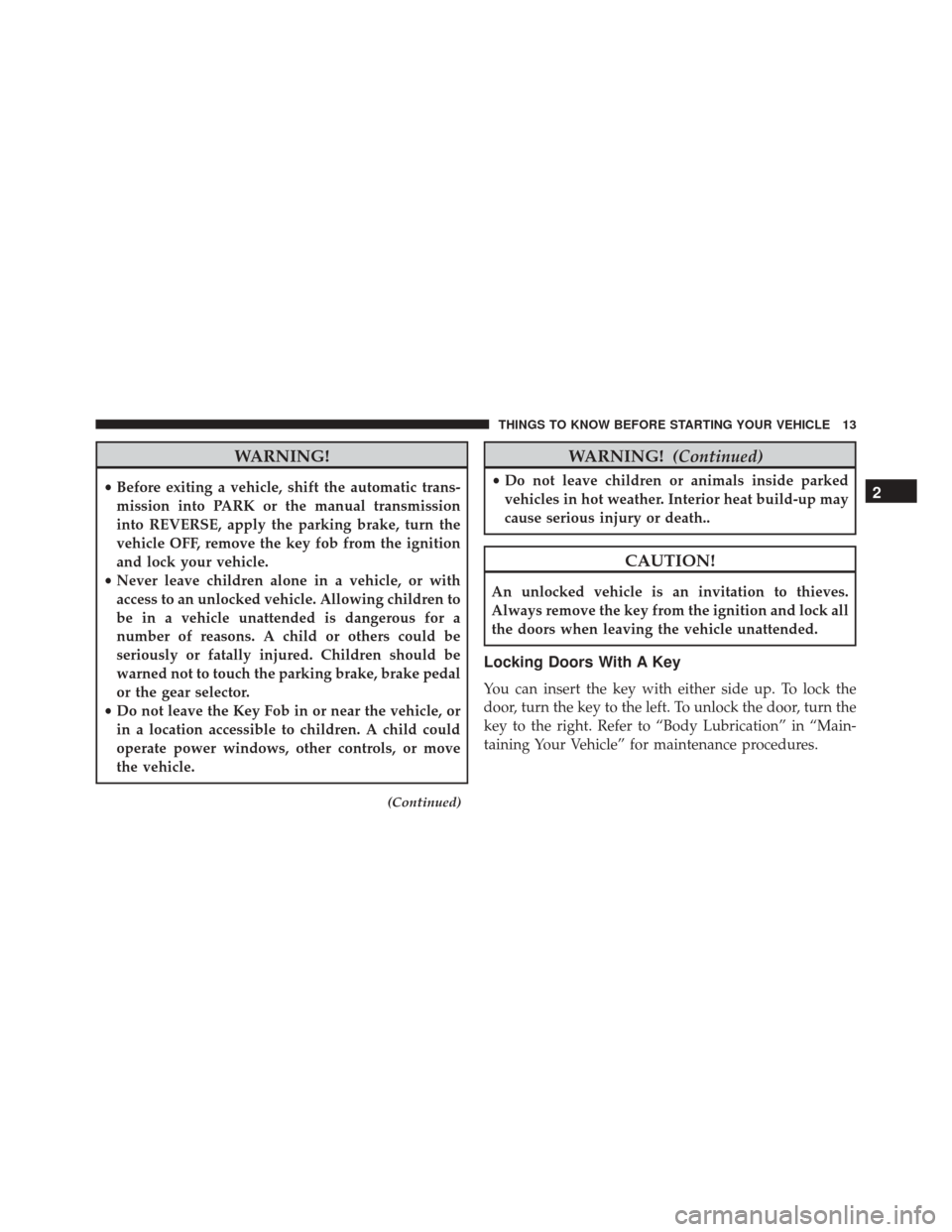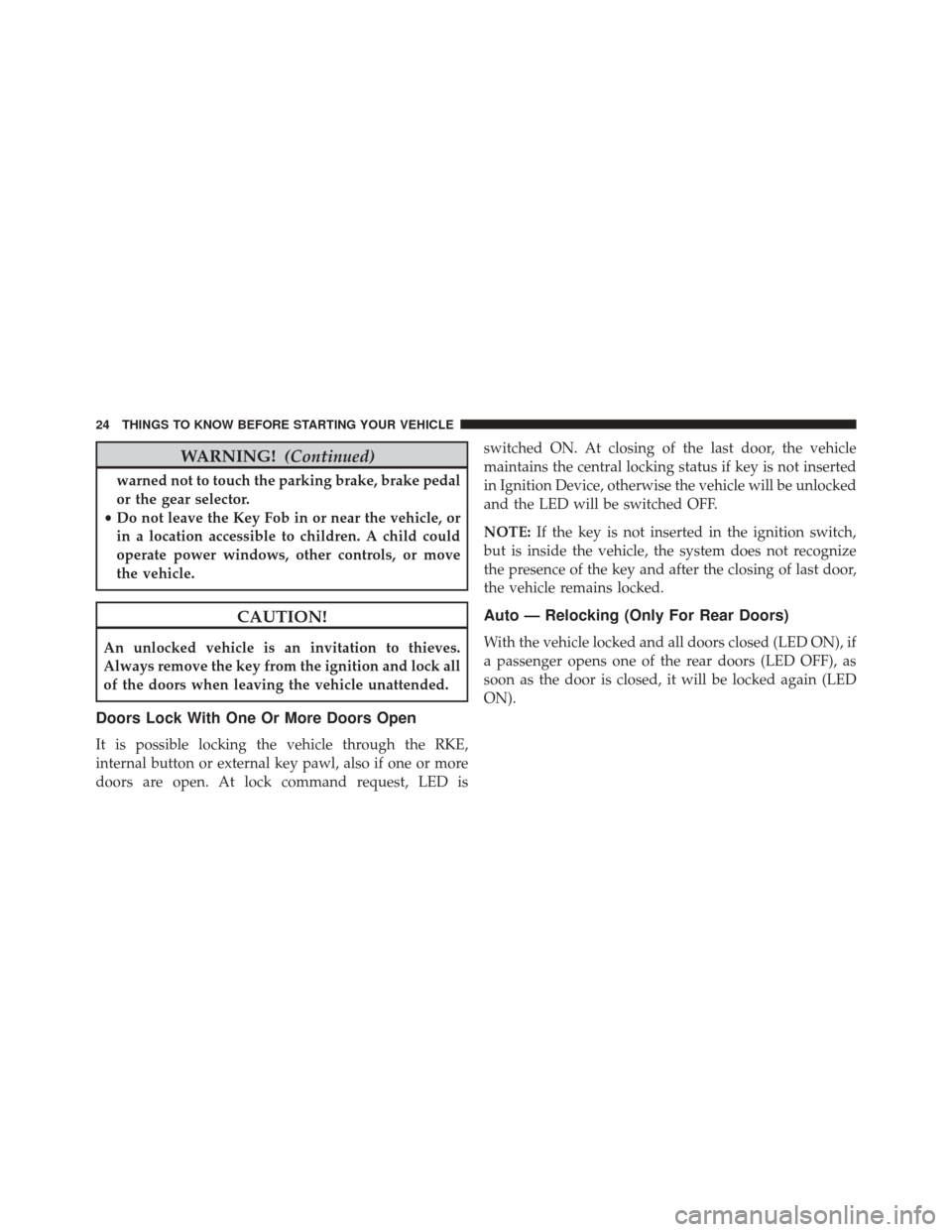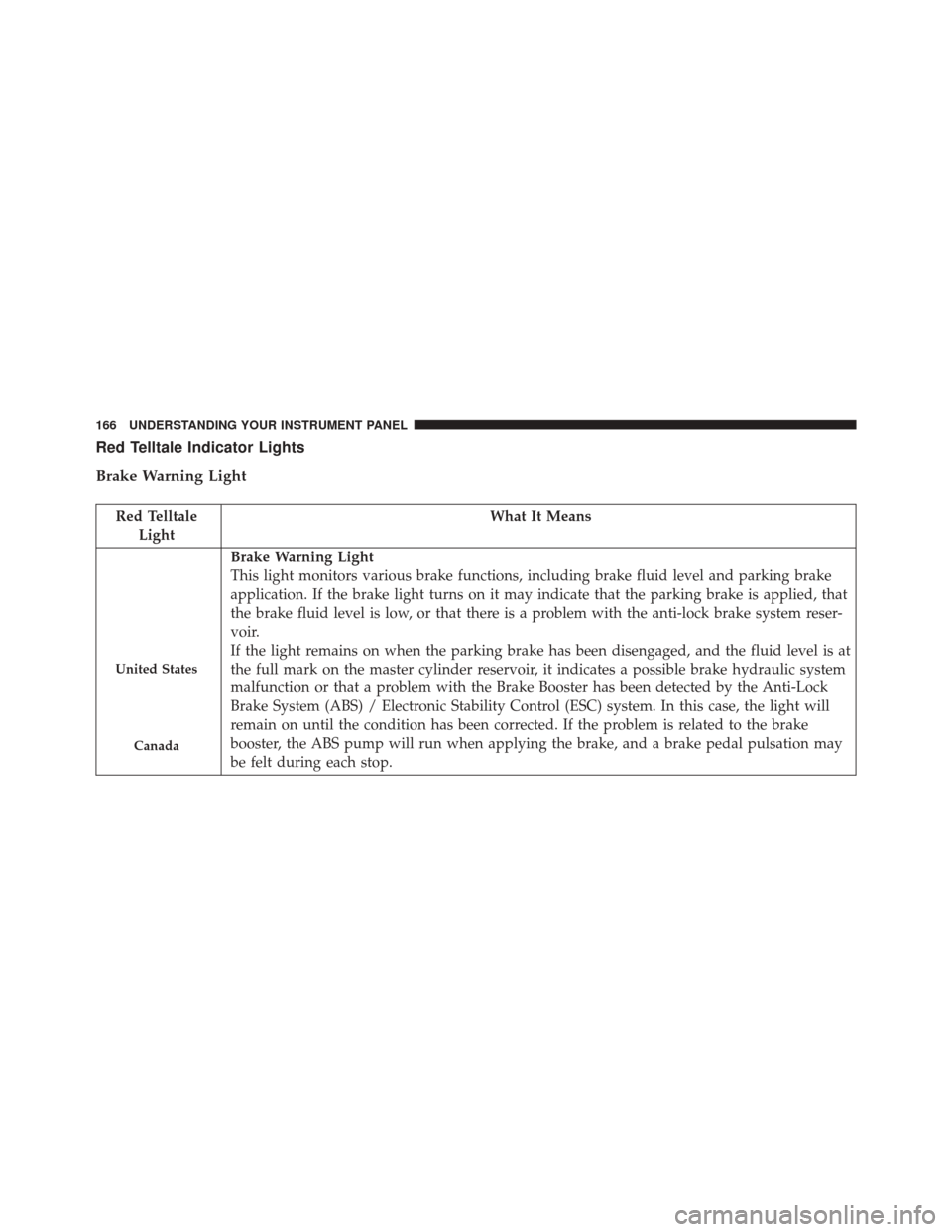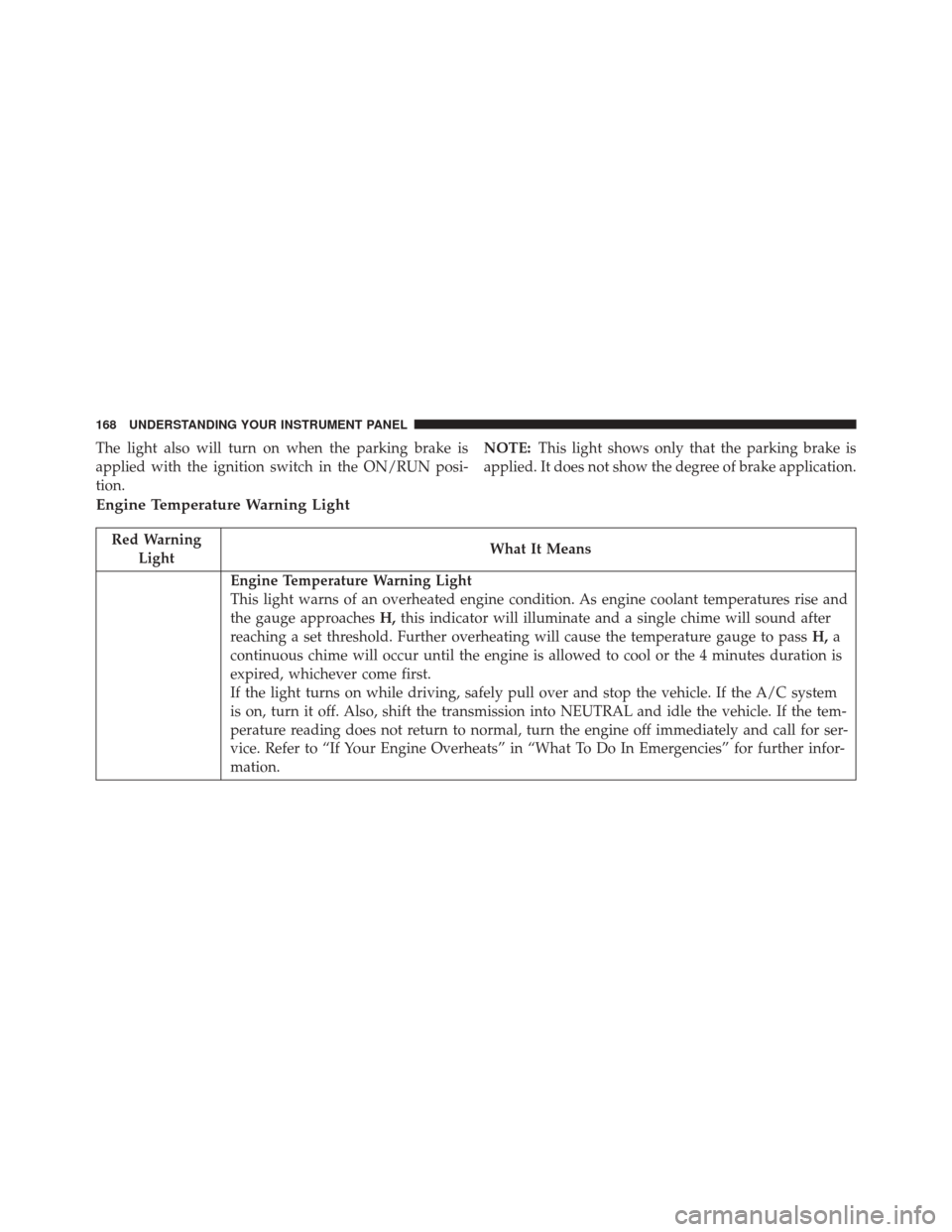Page 15 of 476

WARNING!
•Before exiting a vehicle, shift the automatic trans-
mission into PARK or the manual transmission
into REVERSE, apply the parking brake, turn the
vehicle OFF, remove the key fob from the ignition
and lock your vehicle.
• Never leave children alone in a vehicle, or with
access to an unlocked vehicle. Allowing children to
be in a vehicle unattended is dangerous for a
number of reasons. A child or others could be
seriously or fatally injured. Children should be
warned not to touch the parking brake, brake pedal
or the gear selector.
• Do not leave the Key Fob in or near the vehicle, or
in a location accessible to children. A child could
operate power windows, other controls, or move
the vehicle.
(Continued)
WARNING! (Continued)
•Do not leave children or animals inside parked
vehicles in hot weather. Interior heat build-up may
cause serious injury or death..
CAUTION!
An unlocked vehicle is an invitation to thieves.
Always remove the key from the ignition and lock all
the doors when leaving the vehicle unattended.
Locking Doors With A Key
You can insert the key with either side up. To lock the
door, turn the key to the left. To unlock the door, turn the
key to the right. Refer to “Body Lubrication” in “Main-
taining Your Vehicle” for maintenance procedures.
2
THINGS TO KNOW BEFORE STARTING YOUR VEHICLE 13
Page 25 of 476

NOTE:With central locking active (LED ON), opening
one of the front doors, it is possible to perform a central
unlocking (LED OFF). With central locking active (LED
ON), in order to open one of the rear passenger doors, it
is necessary pulling the internal door handle twice. With
one of the rear door open (LED OFF), the unlocking is
performed only for that door, not for all the vehicle.
To unlock the front doors, pull the inside door handle to
the first detent. If the rear doors are locked, you must pull
the door handle once to unlock the door and pull the
door handle a second time to open the door.WARNING!
• Do not leave children or animals inside parked
vehicles in hot weather. Interior heat build-up may
cause serious injury or death.
• For personal security and safety in the event of a
collision, lock the vehicle doors as you drive as
well as when you park and leave the vehicle.
• Before exiting a vehicle, always apply the parking
brake, shift the automatic transmission into PARK
or the manual transmission into REVERSE, turn
the vehicle OFF, remove the key fob from the
ignition and lock your vehicle.
• Never leave children alone in a vehicle, or with
access to an unlocked vehicle. Allowing children to
be in a vehicle unattended is dangerous for a
number of reasons. A child or others could be
seriously or fatally injured. Children should be
(Continued)
2
THINGS TO KNOW BEFORE STARTING YOUR VEHICLE 23
Page 26 of 476

WARNING!(Continued)
warned not to touch the parking brake, brake pedal
or the gear selector.
• Do not leave the Key Fob in or near the vehicle, or
in a location accessible to children. A child could
operate power windows, other controls, or move
the vehicle.
CAUTION!
An unlocked vehicle is an invitation to thieves.
Always remove the key from the ignition and lock all
of the doors when leaving the vehicle unattended.
Doors Lock With One Or More Doors Open
It is possible locking the vehicle through the RKE,
internal button or external key pawl, also if one or more
doors are open. At lock command request, LED is switched ON. At closing of the last door, the vehicle
maintains the central locking status if key is not inserted
in Ignition Device, otherwise the vehicle will be unlocked
and the LED will be switched OFF.
NOTE:
If the key is not inserted in the ignition switch,
but is inside the vehicle, the system does not recognize
the presence of the key and after the closing of last door,
the vehicle remains locked.
Auto — Relocking (Only For Rear Doors)
With the vehicle locked and all doors closed (LED ON), if
a passenger opens one of the rear doors (LED OFF), as
soon as the door is closed, it will be locked again (LED
ON).
24 THINGS TO KNOW BEFORE STARTING YOUR VEHICLE
Page 87 of 476
lodged in the tread or sidewall. Inspect the tread for cuts
and cracks. Inspect sidewalls for cuts, cracks and bulges.
Check the wheel bolts for tightness. Check the tires
(including spare) for proper cold inflation pressure.
Lights
Have someone observe the operation of brake lights and
exterior lights while you work the controls. Check turn
signal and high beam indicator lights on the instrument
panel.
Door Latches
Check for proper closing, latching, and locking.
Fluid Leaks
Check area under vehicle after overnight parking for fuel,
engine coolant, oil, or other fluid leaks. Also, if gasoline
fumes are detected or if fuel, power steering fluid (if
equipped), or brake fluid leaks are suspected. The cause
should be located and corrected immediately.
2
THINGS TO KNOW BEFORE STARTING YOUR VEHICLE 85
Page 147 of 476
CIGAR LIGHTER — IF EQUIPPED
This is located on the central tunnel, next to the parking
brake lever. To activate the cigar lighter, push and release
the knob. After a few seconds the knob automatically
returns to its initial position, and the cigar lighter is ready
for use.
Cigar Lighter — If Equipped
3
UNDERSTANDING THE FEATURES OF YOUR VEHICLE 145
Page 168 of 476

Red Telltale Indicator Lights
Brake Warning Light
Red TelltaleLight What It Means
United States
Canada
Brake Warning Light
This light monitors various brake functions, including brake fluid level and parking brake
application. If the brake light turns on it may indicate that the parking brake is applied, that
the brake fluid level is low, or that there is a problem with the anti-lock brake system reser-
voir.
If the light remains on when the parking brake has been disengaged, and the fluid level is at
the full mark on the master cylinder reservoir, it indicates a possible brake hydraulic system
malfunction or that a problem with the Brake Booster has been detected by the Anti-Lock
Brake System (ABS) / Electronic Stability Control (ESC) system. In this case, the light will
remain on until the condition has been corrected. If the problem is related to the brake
booster, the ABS pump will run when applying the brake, and a brake pedal pulsation may
be felt during each stop.
166 UNDERSTANDING YOUR INSTRUMENT PANEL
Page 169 of 476

The dual brake system provides a reserve braking capac-
ity in the event of a failure to a portion of the hydraulic
system. A leak in either half of the dual brake system is
indicated by the Brake Warning Light, which will turn on
when the brake fluid level in the master cylinder has
dropped below a specified level.
The light will remain on until the cause is corrected.
NOTE:The light may flash momentarily during sharp
cornering maneuvers, which change fluid level condi-
tions. The vehicle should have service performed, and
the brake fluid level checked.
If brake failure is indicated, immediate repair is neces-
sary.WARNING!
Driving a vehicle with the red brake light on is
dangerous. Part of the brake system may have failed.
It will take longer to stop the vehicle. You could have
a collision. Have the vehicle checked immediately.
Vehicles equipped with the Anti-Lock Brake System
(ABS) are also equipped with Electronic Brake Force
Distribution (EBD). In the event of an EBD failure, the
Brake Warning Light will turn on along with the ABS
Light. Immediate repair to the ABS system is required.
Operation of the Brake Warning Light can be checked by
turning the ignition switch from the OFF position to the
ON/RUN position. The light should illuminate for ap-
proximately two seconds. The light should then turn off
unless the parking brake is applied or a brake fault is
detected. If the light does not illuminate, have the light
inspected by an authorized dealer.
4
UNDERSTANDING YOUR INSTRUMENT PANEL 167
Page 170 of 476

The light also will turn on when the parking brake is
applied with the ignition switch in the ON/RUN posi-
tion.NOTE:
This light shows only that the parking brake is
applied. It does not show the degree of brake application.
Engine Temperature Warning Light
Red Warning Light What It Means
Engine Temperature Warning Light
This light warns of an overheated engine condition. As engine coolant temperatures rise and
the gauge approaches
H,this indicator will illuminate and a single chime will sound after
reaching a set threshold. Further overheating will cause the temperature gauge to pass H,a
continuous chime will occur until the engine is allowed to cool or the 4 minutes duration is
expired, whichever come first.
If the light turns on while driving, safely pull over and stop the vehicle. If the A/C system
is on, turn it off. Also, shift the transmission into NEUTRAL and idle the vehicle. If the tem-
perature reading does not return to normal, turn the engine off immediately and call for ser-
vice. Refer to “If Your Engine Overheats” in “What To Do In Emergencies” for further infor-
mation.
168 UNDERSTANDING YOUR INSTRUMENT PANEL